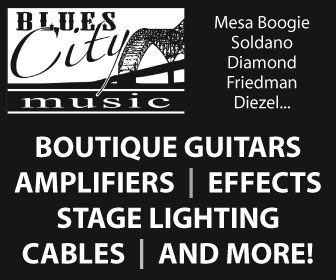Red Engine Nine
Spotlight: Domenick Carino and Gary Smith
The approach to a two-guitar attack usually heads down separate paths. The condensing of two six-stringed instruments can produce texture or it can produce mush. To help prevent the latter, the guitar parts can meet at a safe middle point where each chord is doubled by the guitarists.
The route toward a textured guitar sound is a dangerous and tricky one requiring communication between the two players. Studio effects and musical theory being thrown in the mix makes this an even more challenging task. Sometimes the dangerous road is taken. In safer cases, both guitarists play the same thing. Each approach can produce successful results, the key is deciding which fits and how it relates to the song.
Domenick Carino and Gary Smith meld their sounds together to produce something that further defines their band's sound. Red Engine Nine roots itself with standard rock themes, but is modernized with their swirling emotional axe work.
Their attack starts with Carino's humming strums and arpeggios driving into Smith's melodic song crafting and bluesy lead breaks. "There is nothing worse than two guitars playing exactly the same thing, so we try to utilize them to compliment each other right down to the sounds we use," said Smith.
On their CD, "Wishing to Elvis," Smith and Carino play in two separate styles, but find enough common ground to benefit their songs. "Dom has a more bassy tone and I tend to use a brighter sound to float on top of the rhythm," said Smith. "From a melody standpoint, we try to write parts that contrast [with] each other. It just makes for a more textured sound."
Having two guitarists is an advantage that can't be taken for granted. Bands like the Rolling Stones and Aerosmith would certainly not be the same with just one player.
Dissecting Smith and Carino's influences leads to a better understanding of how their sound is formed. Bands Carino cited, Weezer, Tesla and Pearl Jam, utilize two guitarists much like his band does. They do it with tons of bass in the rhythm and treble in the lead. One guy handles the melody, the other handles the grungy excursions from the scale.
Smith cited a more eccentric group of space-age influences, Frank Zappa, King Crimson and Adrian Belew. The collection of avant-garde artists he listens to helps with the band's goal of creating a fresh sound. "We are very conscious about songs sounding the same," he said. "The last thing we want people to do is come to a show and not be able to pick out a song they liked." The band manages to branch out instrumentally, without detracting from the strong political commentary and sensitivity conveyed in their music. "Many bands have a certain sound and all their songs sound like that," said Smith. "So, in effect, the whole set sounds like that certain sound. I think we have a good mix of melody and emotion with harder rock. We just try to capitalize on melodies."
Dom Carino's Gear
Guitars: Fender Telecasters and Gibson Les Paul
Amp: Line 6
Pedals: Boss Blues Driver, Ibanez Phaser, Danelectro Tremolo
"The Line 6 is great for me because I mainly play rhythm. I bought the floor pedal for it and set up 3 channels (which took about a month, there are way too many settings). I tend to use a fatter, bassier tonality because Gary covers the high end with his start. That's one of the reasons I choose Teles and my Les Paul. Collectively we dialed in our tones together to make the sound form a full package. My channel settings are fairly simple one clean two medium drive and three heavy. I don't even know what amp models I dialed. It was a trail and error process to find the exact setting I use now. I'll use the blues driver on top of one or two depending on what's needed and occasionally on channel three for a big ending. We frown upon a hissy mess of two guitar players battling for who's on top. Each song has its own vibe so we try to match the sound of the band as a whole rather than just getting two killer guitar sounds and then mashing them together."
Gary Smith's Gear
Guitars: Various Fender American Standard Stratocasters
Amp: Mesa Nomad 4x10
Pedals: Tube Screamer, Boss Overdrive, CE-1 Chorus, DD3 Delay,
Cry-Baby Wah
"The amp has three channels, I only use channels one and two (clean and heavy drive). For solos, the Mesa has a boost channel that brings up the volume just enough to put me on top of the band. For different sounds, I combine the drive pedals with themselves or layer the Boss on top of channel 2 (drive) depending on how exaggerated I want my sound. I try to get an even contrast with whatever the rhythm guitar is set on. I hate to have two guitars sounding the same. We seem to get a much fuller sound when one of us is clean and the other dirty (depending on the song). One of the tricks I use is switching between my pickups, even for one bar, to add texture for a heavy down beat or something to that effect. I also use the two drive pedals together for a vintage sound, which the Mesa doesn't do so well. I set the Boss OD low with the level up and the Tube Screamer High with the level down. This gets me a glassy tube sound but not over-the-top like the Mesa."

Josh Davidson has written music feature articles for Jersey Style and served as the Jersey Shore rock columnist for Steppin' Out Magazine. Other music writing credits include Aquarian Weekly, Jersey Beat, Backstreets and njcoast.com. He has written free-lance for the Asbury Park Press' Community Sports section and has written featured articles for its news section, as well as covering campus news and sports weekly for the Signal, the College of New Jersey's (formerly Trenton State College) student newspaper. He has worked as a staff writer for The Independent, and his work for Greater Media Newspapers has also been published in the News Transcript. He is a former beat reporter for the Ocean County Observer who presently is a news writer for Symbolic Systems Inc. supporting the US Army's Knowledge Center. His music writing covers a vast range of topics, from the current cover band craze, highs and lows of the original scene, to the early days of the Jersey Shore rock scene in Asbury Park. He is also a musician, having written hundreds of songs as a singer/songwriter, and playing them out as a solo/acoustic artist. He has also played with cover bands, including It Doesn't Matter, and several original bands, including as the guitarist for the solo project of singer/songwriter Dave Eric. He continues to work on solo material and is presently the guitar player for Jersey Breeze.









